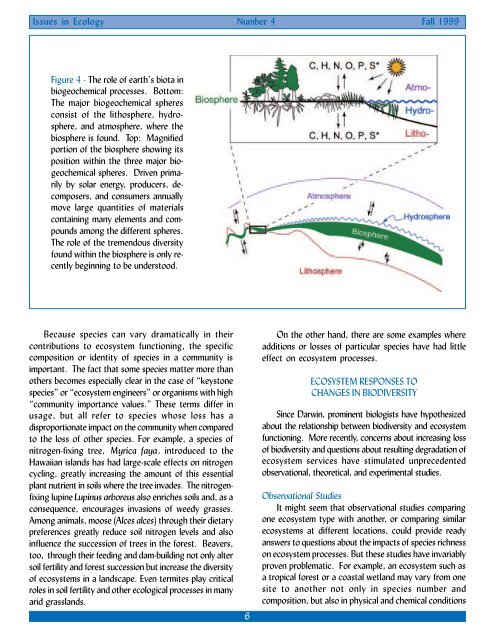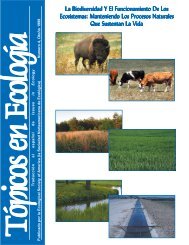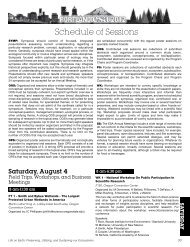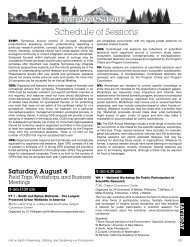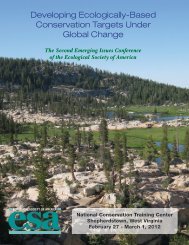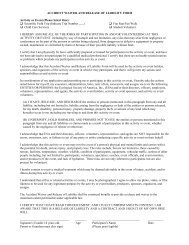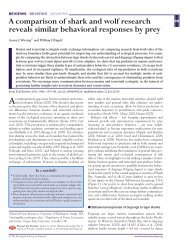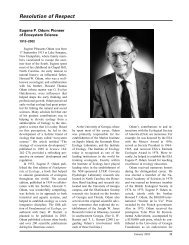Biodiversity and Ecosystem Functioning - Ecological Society of ...
Biodiversity and Ecosystem Functioning - Ecological Society of ...
Biodiversity and Ecosystem Functioning - Ecological Society of ...
Create successful ePaper yourself
Turn your PDF publications into a flip-book with our unique Google optimized e-Paper software.
Issues in Ecology Number 4 Fall 1999<br />
Figure 4 - The role <strong>of</strong> earth’s biota in<br />
biogeochemical processes. Bottom:<br />
The major biogeochemical spheres<br />
consist <strong>of</strong> the lithosphere, hydrosphere,<br />
<strong>and</strong> atmosphere, where the<br />
biosphere is found. Top: Magnified<br />
portion <strong>of</strong> the biosphere showing its<br />
position within the three major biogeochemical<br />
spheres. Driven primarily<br />
by solar energy, producers, decomposers,<br />
<strong>and</strong> consumers annually<br />
move large quantities <strong>of</strong> materials<br />
containing many elements <strong>and</strong> compounds<br />
among the different spheres.<br />
The role <strong>of</strong> the tremendous diversity<br />
found within the biosphere is only recently<br />
beginning to be understood.<br />
Because species can vary dramatically in their<br />
contributions to ecosystem functioning, the specific<br />
composition or identity <strong>of</strong> species in a community is<br />
important. The fact that some species matter more than<br />
others becomes especially clear in the case <strong>of</strong> “keystone<br />
species” or “ecosystem engineers” or organisms with high<br />
“community importance values.” These terms differ in<br />
usage, but all refer to species whose loss has a<br />
disproportionate impact on the community when compared<br />
to the loss <strong>of</strong> other species. For example, a species <strong>of</strong><br />
nitrogen-fixing tree, Myrica faya, introduced to the<br />
Hawaiian isl<strong>and</strong>s has had large-scale effects on nitrogen<br />
cycling, greatly increasing the amount <strong>of</strong> this essential<br />
plant nutrient in soils where the tree invades. The nitrogenfixing<br />
lupine Lupinus arboreus also enriches soils <strong>and</strong>, as a<br />
consequence, encourages invasions <strong>of</strong> weedy grasses.<br />
Among animals, moose (Alces alces) through their dietary<br />
preferences greatly reduce soil nitrogen levels <strong>and</strong> also<br />
influence the succession <strong>of</strong> trees in the forest. Beavers,<br />
too, through their feeding <strong>and</strong> dam-building not only alter<br />
soil fertility <strong>and</strong> forest succession but increase the diversity<br />
<strong>of</strong> ecosystems in a l<strong>and</strong>scape. Even termites play critical<br />
roles in soil fertility <strong>and</strong> other ecological processes in many<br />
arid grassl<strong>and</strong>s.<br />
6<br />
On the other h<strong>and</strong>, there are some examples where<br />
additions or losses <strong>of</strong> particular species have had little<br />
effect on ecosystem processes.<br />
ECOSYSTEM RESPONSES TO<br />
CHANGES IN BIODIVERSITY<br />
Since Darwin, prominent biologists have hypothesized<br />
about the relationship between biodiversity <strong>and</strong> ecosystem<br />
functioning. More recently, concerns about increasing loss<br />
<strong>of</strong> biodiversity <strong>and</strong> questions about resulting degradation <strong>of</strong><br />
ecosystem services have stimulated unprecedented<br />
observational, theoretical, <strong>and</strong> experimental studies.<br />
Observational Studies<br />
It might seem that observational studies comparing<br />
one ecosystem type with another, or comparing similar<br />
ecosystems at different locations, could provide ready<br />
answers to questions about the impacts <strong>of</strong> species richness<br />
on ecosystem processes. But these studies have invariably<br />
proven problematic. For example, an ecosystem such as<br />
a tropical forest or a coastal wetl<strong>and</strong> may vary from one<br />
site to another not only in species number <strong>and</strong><br />
composition, but also in physical <strong>and</strong> chemical conditions


